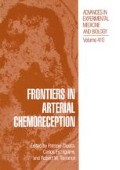Abstract
Experiments in vitro showed that the frequency of carotid chemosensory discharges (f x) increases in response to appropriate physiological and pharmacological stimuli in the nominal absence of CO2-HCO3 − (Eyzaguirre & Lewin 1961; Iturriaga & Lahiri, 1991). In studies with isolated glomus cells bathed with media without CO2-HCO3 −, hypoxia diminished the membrane K+ conductance (López et al, 1989; Peers & Green 1991) and increased intracellular free [Ca2+] (Biscoe & Duchen, 1988). Thus, the presence of CO2-HCO3− in the in vitro medium is not required for the generation of the hypoxic chemosensory response. Nevertheless, the presence of CO2-HCO3 − in the in vitro medium sped up the onset and the rate of rise of the cat chemosensory responses to hypoxia, flow interruption and NaCN, as compared with the responses obtained when the CBs were perfused with medium buffered at the same pH 7.40 (Iturriaga & Lahiri, 1991; Shirahata & Fitzgerald, 1993).
Access this chapter
Tax calculation will be finalised at checkout
Purchases are for personal use only
Preview
Unable to display preview. Download preview PDF.
References
Biscoe TJ & Duchen MR (1988) Electrophysiological responses of dissociated type I cells of the rabbit carotid body to cyanide. J Physiol, London 405: 210–232
Black AMS, McCloskey DI & Torrance RW (1971) The response of carotid body chemoreceptors in the cat to sudden changes of hypercapnic and hypoxic stimuli. Respir Physiol 13: 36–49
Buckler KJ & Vaughan-Jones RD (1993) Effects of acidic stimuli on intracellular calcium in isolated type I cells of the neonatal rat carotid body. Pflügers Arch 425: 22–27
Buckler KJ, Vaughan-Jones RD, Peers C & Nye PCG (1991) Intracellular pH and its regulation in the isolated type I carotid body cells of the neonatal rat. J Physiol, London 436: 107–129
Eyzaguirre C & Lewin J (1961) Effects of different oxygen tension of the carotid body in vitro. J Physiol, London 159:238–250
González C, Almaraz L, Obeso A & Rigual R (1994) Carotid body chemoreceptors: From natural stimuli to sensory discharges. Physiol Rev 74: 829–898
Hanson MA, Nye PCG & Torrance RW (1981) The exodus of an extracellular bicarbonate theory of chemorecep-tion and the genesis of an intercellular one. In: Belmonte C, Pallot C, Acker H & Fidone S (eds) Arterial Chemoreceptors. Leicester: Leicester University Press. pp 403–416
He S-F, Wei J-Y & Eyzaguirre C (1991) Effects of relative hypoxia and hypercapnia on intracellular pH and membrane potential of cultured carotid body glomus cells. Brain Res 556: 333–338
Iturriaga R & Lahiri S (1991) Carotid body chemoreception in the absence and presence of CO2-HCO3 −. Brain Res 568: 253–260
Iturriaga R, Rumsey WL, Lahiri S, Spergel D & Wilson DF (1992) Intracellular pH and O2 chemoreception in the cat carotid body in vitro. J Appl Physiol 72: 2259–2266
Iturriaga R, Mokashi A & Lahiri S (1993) Dynamics of the carotid body responses in vitro in the presence of CO2-HCO3 −: Role of carbonic anhydrase. J Appl Physiol 75: 1587–1594
Lahiri S & DeLaney RG (1975) Stimulus interaction in the responses of carotid body chemoreceptors single fibers. Respir Physiol 24: 249–266
Lahiri S & Iturriaga R (1993) Role of ion exchangers in the carotid body chemotransduction. Adv Exp Med Biol 337:177–182
López-López J, González C, Ureña J & López-Barneo J (1989) Low PO2 selectively inhibits K channel activity in chemoreceptor cells of the mammalian carotid body. J Gen Physiol 93: 1001–1015
Mokashi A, Ray D, Botre F, Katayama M, Osani S & Lahiri S (1995) Effect of hypoxia on intracellular pH of the glomus cell cultured from cat and rat carotid bodies. J Appl Physiol 78: 1875–1881
Peers C & Green FK (1991) Inhibition of Ca2+-activated K+ current by intracellular acidosis in isolated type I cells of the neonatal rat carotid body. J Physiol, London 437: 589–602
Sato M (1994) Effects of CO2, acetate and lowering extracellular pH on Ca2+ and pH on cultured glomus cells of the newborn rabbit carotid body. Neurosci Lett 173: 159–162
Shirahata M & Fitzgerald RS (1993) Role of carbon dioxide for hypoxic chemotransduction of the cat carotid body. Adv Exp Biol Med 337:213–219
Stea A, Alexander SA & Nurse CA (1991) Effect of pHi and pHe on membrane currents recorded with perforated-patch method from cultured chemoreceptors of the rat carotid body. Brain Res 567: 83–90
Wilding TJ, Cheng B & Roos A (1992) pH regulation in adult rat carotid body glomus cells. Importance of extracellular pH, sodium and potassium. J Gen Physiol 100: 593–608
Author information
Authors and Affiliations
Editor information
Editors and Affiliations
Rights and permissions
Copyright information
© 1996 Springer Science+Business Media New York
About this chapter
Cite this chapter
Iturriaga, R. (1996). Intracellular Acidosis Potentiates Carotid Chemoreceptor Responses to Hypoxia in the Absence of CO2-HCO3 − . In: Zapata, P., Eyzaguirre, C., Torrance, R.W. (eds) Frontiers in Arterial Chemoreception. Advances in Experimental Medicine and Biology, vol 410. Springer, Boston, MA. https://doi.org/10.1007/978-1-4615-5891-0_30
Download citation
DOI: https://doi.org/10.1007/978-1-4615-5891-0_30
Publisher Name: Springer, Boston, MA
Print ISBN: 978-1-4613-7702-3
Online ISBN: 978-1-4615-5891-0
eBook Packages: Springer Book Archive

